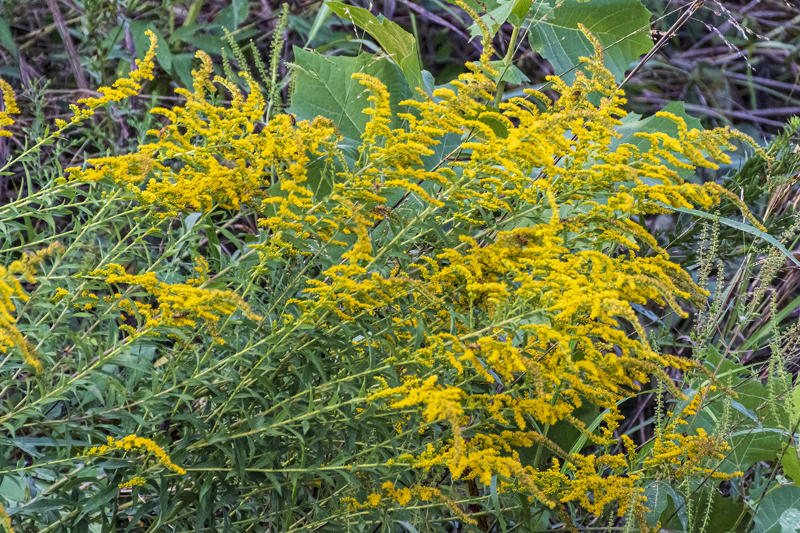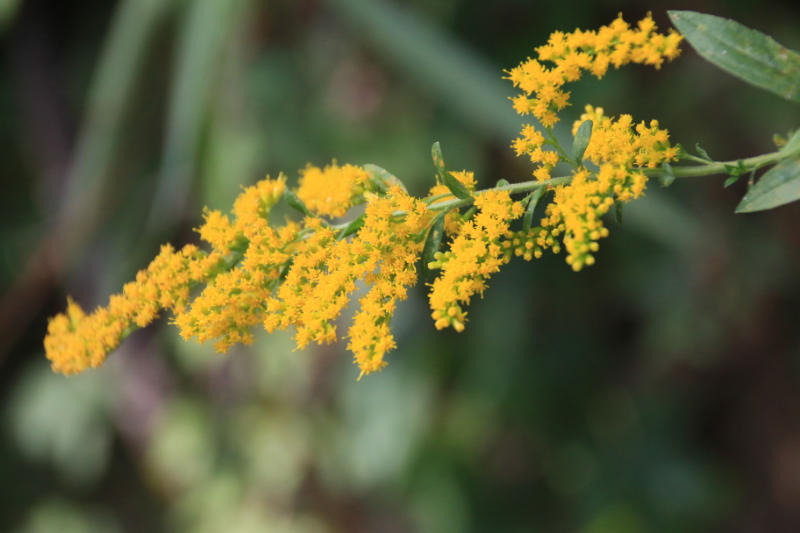Late summer announces its arrival with the blooming of Goldenrod, its vibrant golden flowers hard to miss. The first part of its Latin name, Solidago, as in Solidago canadensis, means “to make whole,” a testament to how our forefathers viewed this exceptional plant.
However, Goldenrod has been unfairly accused of causing allergy symptoms. Those unaware of its properties often blame the plant for their discomfort. Nonetheless, it is guilt by association. Goldenrod’s pollen is primarily spread by insects and is heavy and sticky, making it unlikely to cause allergic reactions. In contrast, Ragweed pollen is a potent allergen and is usually the cause of seasonal allergy symptoms.
Goldenrod and Ragweed bloom almost simultaneously and can often be found growing side by side, thriving in the same growing conditions. One caveat to this is that some florists and other professionals who handle Goldenrod frequently have reported developing an allergy to it. So, if you are allergic to Ragweed, there is a possibility that you may have an allergic reaction to Goldenrod as well.
Despite this, Goldenrod is a versatile herb with many medicinal properties, including its actions on the urinary tract, kidneys, skin, cardiovascular system, and allergies. Although there is little scientific research on its health benefits, traditional folk medicine has used it for many years. We know a lot about the plant itself and its chemical components, which may be responsible for its reported effects.
Goldenrod has anti-inflammatory, anti-fungal, antiseptic, diaphoretic, diuretic, expectorant, and astringent properties.
Let’s look at some uses of Goldenrod more closely.

Goldenrod for Muscle & Arthritis Pain
Create a potent infused oil using Goldenrod, and utilize its anti-inflammatory properties to alleviate discomfort in sore muscles and painful joints. The oil can also work wonders in reducing swelling and itching caused by insect bites and other skin irritations. Additionally, it can aid in treating wounds and burns by soaking a dressing in the oil and applying it to the affected area. This can help reduce swelling and alleviate pain.
Goldenrod’s therapeutic properties have been utilized for centuries to treat a wide range of medical conditions. Although scientific studies on its effectiveness are limited, traditional herbal medicine practitioners have been using it to treat a variety of ailments for generations. With its anti-inflammatory, anti-fungal, antiseptic, diaphoretic, diuretic, expectorant, and astringent properties, Goldenrod has been known to help with urinary tract and kidney issues, cardiovascular ailments, and allergies.
Stop Bleeding
Goldenrod’s dried leaves possess incredible hemostatic properties and can be crushed and used as a natural remedy to stop bleeding in cuts and wounds. In fact, these leaves can be used as a substitute for styptic powder often utilized after shaving to treat minor cuts. In case of an emergency where medical aid is unavailable, you can even create a poultice by slightly chewing the goldenrod leaves and applying it over the bleeding wound to stop the bleeding.
A Great Source Of Antioxidants
Brewing a cup of tea using goldenrod leaves can be a great way to benefit from the flavonoid, rutin. Rutin is a potent antioxidant that can improve cardiovascular health by reducing the amount of harmful oxygen free radicals in the body. These free radicals can cause oxidative damage to cells and are a significant contributor to cell aging and functional decline. Therefore, consuming foods rich in antioxidants, such as goldenrod, can help protect cells against the damaging effects of free radicals and promote healthy aging.

Ways To Use Goldenrod
It can be used in these ways:
- Dry the upper 1/3 of the plant and make a tea
- Make a tincture
- Make an infused oil
Let’s look at each of these and the uses for each in your natural medicinal arsenal.
Tea
There are a variety of methods to create a healing tea using goldenrod. One easy technique involves cutting the upper third of the plant above a leaf joint and tying the tops together before hanging them upside down in a location with good airflow. Once the leaves have dried, they can be stripped easily from the stem and stored in an airtight container for future use. Alternatively, you can strip the leaves and flowers and use a food dehydrator to dry them.
To prepare the tea, add 2 tablespoons of dried goldenrod to a cup and pour boiling water over it. After allowing it to steep for 10-15 minutes, strain the mixture and enjoy. Honey can be used to sweeten the tea, but I find it to be quite palatable on its own with a slightly sweet flavor and a barely noticeable bitter aftertaste. Note that the taste may differ depending on the type of goldenrod you are using, as there are over 100 different types available. Adding honey to the tea provides additional health benefits from the natural ingredients, creating a powerful and healthy combination.
Goldenrod Tincture
A tincture is a type of infusion made using high-quality alcohol, such as vodka or grain alcohol, with a minimum alcohol content of 40%. This equates to an alcohol of at least 80 proof, regardless of which type you choose. It is worth noting that increasing the alcohol proof does not seem to have a significant impact on the final product. However, it is important to select a type of alcohol that has an acceptable taste, as tinctures are meant to be taken orally. If the taste is unpalatable, the tincture may simply sit unused on the shelf.
Infused Oil
An infused oil is a carrier oil that has been infused with medicinal plants. The process of making infused oil is straightforward. First, you need to fill a jar with the parts of the plant that you are working with, making sure to cut them into sections small enough to fit through the opening of the jar. A one-quart mason jar should be sufficient. Next, you can use any carrier oil of your choice to fill the jar. If you want to learn more about carrier oils, you can refer to this article.
The easiest method to create infused oil is to seal the jar and store it in a cabinet for 6-8 weeks. During this time, the oil will extract the beneficial properties of the plant. Once the infusion is ready, the oil can be used topically as is or can be combined with beeswax and shea butter to create a salve or balm. You can find many recipes online to make a balm that suits your preferences.
If you are in a hurry, you can use the heat method to make your infused oil. This method is a little more work, but it produces oil in a much shorter time frame – usually 3-4 days. The heat method involves slowly heating the oil and plant material in a double boiler or crockpot until the oil takes on the color of the plant material. For Goldenrod, the oil will turn a beautiful golden color. Once the oil is infused, you can use it to make your salves or balms by melting beeswax and mixing it in the oil. You can also add ingredients like shea butter or vitamin E oil to make your salve or balm even more nourishing and beneficial for your skin.
If you would like information on other wild medicinal plants you can read some of our other articles such as this one on Mullein. Be sure and check out our list of articles to discover a wealth of information on other wild edible and medicinal plants.
Disclaimer: This article should not be construed as medical advice. The health information in this article is not intended to assess, diagnose, prescribe, or promise a cure for any medical condition. Consult with your health care professional before considering any natural supplement or plant remedy for your health and wellness. We assume no liability for the use or misuse of the material presented above. Always consult with a medical professional before changing your diet, or using manufactured or natural medications.
FAQs:
Q: Do I want goldenrod in my garden?
A: Goldenrod can add a beautiful pop of yellow color to your garden, and it’s also beneficial for pollinators like bees and butterflies.
Q: Why do farmers plant goldenrod?
A: Farmers often plant goldenrod as a cover crop to improve soil health and prevent soil erosion. Goldenrod also attracts pollinators, which can benefit other crops nearby.
Q: What does goldenrod symbolize?
A: Goldenrod is a symbol of good fortune and prosperity in many cultures. It’s also seen as a sign of resilience and perseverance due to its ability to thrive in poor soil conditions.
Q: Is there a difference between ragweed and goldenrod?
A: Yes, there is a difference between ragweed and goldenrod. Ragweed is a common allergen that produces a lot of pollen and often causes allergy symptoms, while goldenrod is not usually a cause of allergies.
Q: What are the medical benefits of Goldenrod?
A: Goldenrod has been used for centuries to treat various ailments, including urinary tract infections, respiratory issues, and inflammation. It’s also been found to have antioxidant and anti-inflammatory properties.
Q: How do you prepare Goldenrod for medicinal use?
A: One common way to prepare goldenrod for medicinal use is to make a tincture using the plant’s leaves and flowers. The tincture can be taken orally or used topically.
Q: What is the most medicinal goldenrod?
A: Several species of goldenrod are used medicinally, but Solidago virgaurea (European goldenrod) and Solidago canadensis (Canada goldenrod) are commonly used in herbal medicine.
Q: Can you ingest goldenrod?
A: Yes, goldenrod can be ingested. However, it’s important to consult with a healthcare provider before using any herbal remedies, especially if you have any underlying medical conditions or are taking medications.